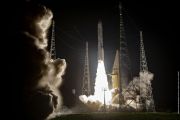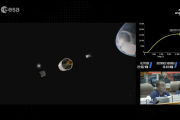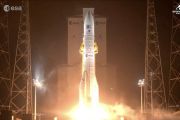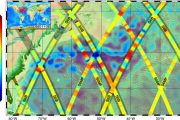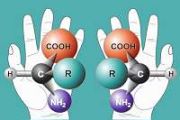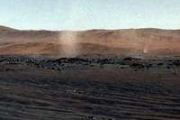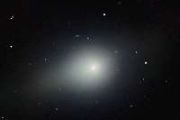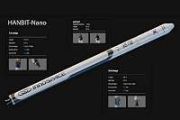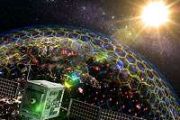
Copernical Team
Instrument issue pauses NASA's James Webb Telescope observations
 Scientists have temporarily paused further observations with NASA's new James Webb telescope after a problem was detected with one of its instruments, the space agency confirmed.
"The Webb team has paused in scheduling observations using this particular observing mode while they continue to analyze its behavior and are currently developing strategies to resume MRS observations as soon a
Scientists have temporarily paused further observations with NASA's new James Webb telescope after a problem was detected with one of its instruments, the space agency confirmed.
"The Webb team has paused in scheduling observations using this particular observing mode while they continue to analyze its behavior and are currently developing strategies to resume MRS observations as soon a American, Russians reach space station as war rages in Ukraine
 A US astronaut and two Russian cosmonauts have arrived safely at the International Space Station (ISS), NASA said Wednesday, after blasting off on a Russian-operated flight in a rare instance of cooperation between Moscow and Washington.
The Russian space agency Roscosmos and NASA both distributed live footage of the launch from Kazakhstan and commentators speaking over the feed said it was
A US astronaut and two Russian cosmonauts have arrived safely at the International Space Station (ISS), NASA said Wednesday, after blasting off on a Russian-operated flight in a rare instance of cooperation between Moscow and Washington.
The Russian space agency Roscosmos and NASA both distributed live footage of the launch from Kazakhstan and commentators speaking over the feed said it was NASA tries fueling moon rocket in test, but leak reoccurs (Update)

A virtual hiking map for Jezero crater, the Mars 2020 Perseverance rover landing site

Prospective Mars explorers can now take a hike around the landing site of NASA's Mars 2020 Perseverance rover with an interactive map loaded with orbital imagery, terrain data as well as synthetic and real 3D panoramic views of Jezero crater and its surrounding area. The map, which can be accessed through a normal web browser, has been presented today at the Europlanet Science Congress (EPSC) 2022 in Granada, Spain, by Sebastian Walter of the Freie Universität Berlin.
"The map is the perfect tool for planning a future visit to Mars, with an interactive interface where you can choose from different available base datasets. Some of the slopes are pretty steep, so watch out for those if you want to avoid too much oxygen consumption!" said Sebastian Walter.
"To get a real feeling of what to expect on your future Mars trip, you can click on one of the waypoint marker symbols to enter either a fullscreen 3D view or, if you have a Virtual Reality setup, to enter a fully immersive environment.
First 3D renders from JunoCam data reveal 'frosted cupcake' clouds on Jupiter

Four-legged jumping robots to explore the moon

A four-legged robot trained through artificial intelligence has learned the same lesson as the Apollo astronauts—that jumping can be the best way to move around on the surface the moon. An update on LEAP (Legged Exploration of the Aristarchus Plateau), a mission concept study supported by ESA to explore some of the most challenging lunar terrains, has been presented today at the Europlanet Science Congress (EPSC) 2022 in Granada by Patrick Bambach.
"LEAP's target is the Aristarchus plateau, a region of the moon that is particularly rich in geologic features but highly challenging to access," said Patrick Bambach of the Max Planck Institute for Solar System Research in Germany. "With the robot, we can investigate key features to study the geologic history and evolution of the moon, like the ejecta around craters, fresh impact sites, and collapsed lava tubes, where material may not have been altered by space weathering and other processes.
Who wants to go to the moon? Europe names astronaut candidates

The European Space Agency announced a team of seven astronauts on Wednesday to train for NASA's Artemis mission to the moon—but only one will have the chance to become the first European to walk on the lunar surface.
The candidates—France's Thomas Pesquet, Britain's Tim Peake, Germany's Alexander Gerst and Matthias Maurer, Italy's Luca Parmitano and Samantha Cristoforetti, and Denmark's Andreas Mogensen—have all completed at least one mission on board the International Space Station.
Between them, the team has the equivalent of 4.5 years in orbit and 98 hours of spacewalking, ESA communications head Philippe Willekens told journalists at the International Astronautical Congress in Paris.
Three of the astronauts will be selected to go to the Lunar Gateway, a planned station that will orbit the moon.
But only one will set foot on the moon by the end of the decade.
Space station gets 3 new residents after Russian launch

The International Space Station welcomed three new residents Wednesday following a smooth Russian launch.
The Soyuz capsule rocketed into orbit from Kazakhstan and, just three hours later, pulled up at the space station.
American, Russians blast off for ISS as war rages in Ukraine (Update)

A US astronaut and two Russian cosmonauts are set to blast off to the International Space Station Wednesday on a Russian-operated flight despite soaring tensions between Moscow and Washington over Russia's invasion of Ukraine.
NASA's Frank Rubio and Russia's Sergey Prokopyev and Dmitry Petelin are scheduled to take off from the Russia-leased Baikonur cosmodrome in Kazakhstan at 1354 GMT, according to Russian space agency Roscosmos.
Rubio will become the first US astronaut to travel to the ISS on a Russian Soyuz rocket since President Vladimir Putin sent troops into pro-Western Ukraine on February 24.
In response, Western capitals including Washington have hit Moscow with unprecedented sanctions and bilateral ties have sunk to new lows.
Weightless on Earth: Preparing astronauts for microgravity


